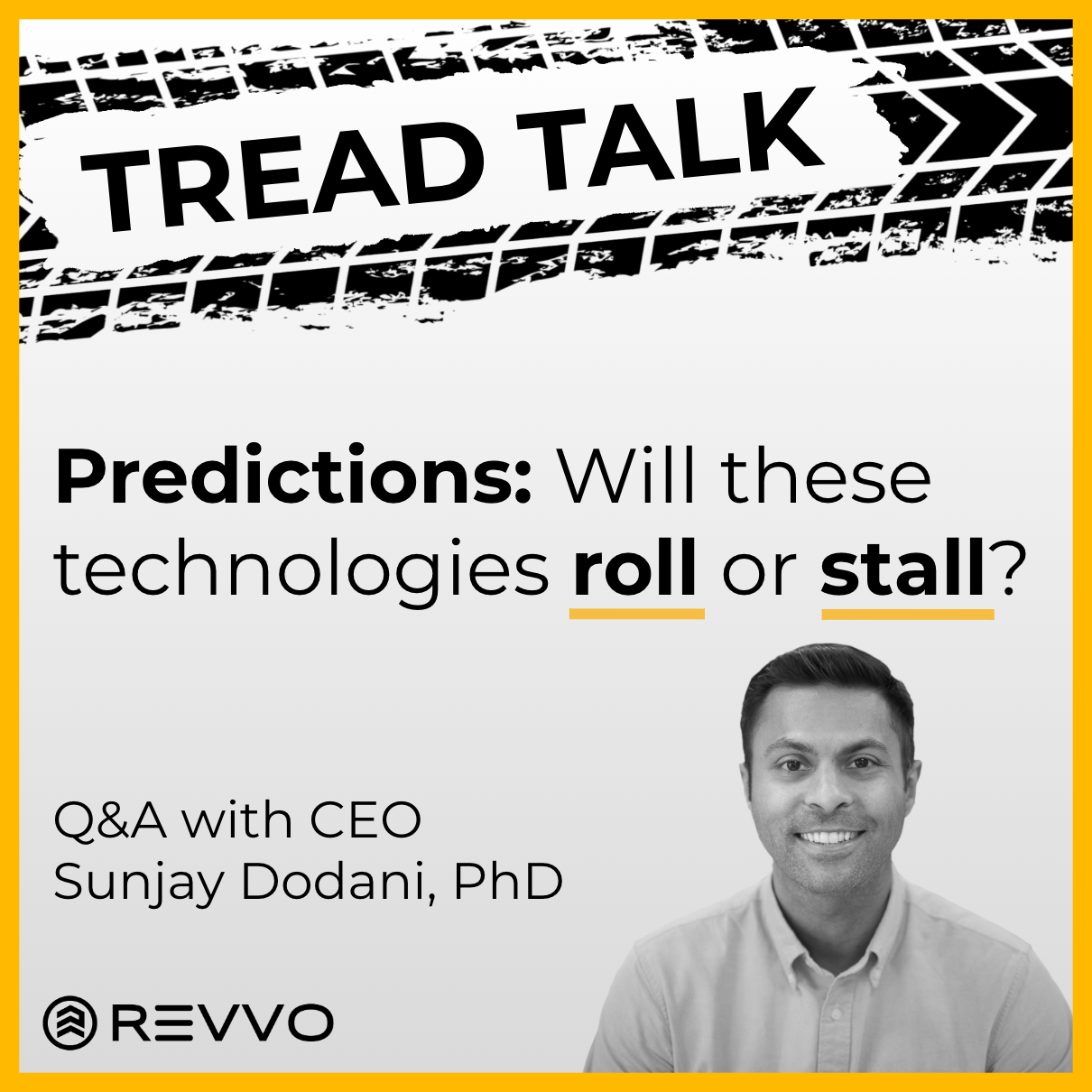Vehicle mobility is evolving drastically — delivery, autonomous driving, and more— yet fundamental risks persist. These risks to safety and cost have seemed unpreventable until now.
Transportation is primed for a safety, uptime, and efficiency overhaul via automated monitoring and management. Artificial intelligence increasingly is appearing in transportation tech solutions that seek to minimize safety risks and cost, with mixed results.
In this interview, Revvo co-founder and CEO Sunjay Dodani, PhD gives his view on AI’s growing use in transportation, and on other popular areas of innovation tire-kicking. Leading the company that’s built an AI-powered tire management platform informed by over 250 million miles of data, Dodani has a strong perspective on where AI and innovation can bring value…or not.
Sunjay, before we hear about where innovation is rolling and where it may stall, why do you think transportation and tech firms are getting so interested in AI now?
Sunjay Dodani: Tire issues account for the majority of costs for vehicle maintenance, downtime, and driver safety, with 2.7 billion tires replaced globally last year at a cost of $250 billion.
Without an intelligent way to analyze massive tire performance datasets, predict maintenance issues, and offer cost-saving insights, we’ll continue to see road risks and suboptimal vehicle performance.
AI has brought efficiency to all kinds of industries—finance, retail, pharmaceutical, even the legal field, and so many others. Transportation’s vast trove of data and GDP impact make it a prime industry for testing the AI waters. For example, Revvo’s TireIQ fleet management solution runs on 375 billion data points processed, with AI sensors detecting about a dozen inputs on each tire every 60 seconds.
OK, so what’s first on your list of “Transportation AI— Roll or Stall”?
Sunjay Dodani: Predictive maintenance AI will definitely roll along well in 2024. AI will shift the classic “scheduled preventative maintenance schedule” for vehicles and only flag vehicles for maintenance based on utilization.
What’s even more interesting is that AI will also optimize the schedules for downtime, to eliminate the planning portion that drags on fleet managers and creates general discontent in fleet operations. Gone will be the days of a fleet manager also having to act as ‘repo man’ to go out and tow vehicles back to the shop because the drivers ignore service reminders.
We’re all feeling the pinch of too many text messages in our daily lives. For maintenance managers, the amount of alerts and triggers for actions could be in the thousands for a fleet of just 300 vehicles. AI will handle the data overload by prioritizing, scheduling and messaging all that needs to be done, so that the manager is less overwhelmed by the volume of alerts and instead focused on communicating actions and tracking KPIs (key performance indicators).
“Gone will be the days of a fleet manager also having to act as ‘repo man’ to go out and tow vehicles back to the shop because the drivers ignore service reminders.”
Let’s talk about another human element of using AI: the drivers who rely on AI-powered apps to deliver packages, people, and food. Are flex driver businesses here to stay, or will they be an AI-complemented business model that eventually stalls out?
Sunjay Dodani: Flex drivers relying on AI tools are here to stay, they’ll keep rolling. But the bigger unanswered question is, Who’s responsible?
This question is crucial for Last Mile delivery trucks as they expand in peak times, as well as for the concept of Uber drivers. Ultimately, the maintenance of the vehicle is the responsibility of the driver, but that driver can be penalized by the contracting employer. I think this is often overlooked and swept under the rug after the initial general inspection is done. As just one benefit of AI-powered maintenance monitoring, constant analysis of vehicle maintenance can uphold brand reputation and even support a marketing campaign for always keeping drivers and riders safe.
We’ve talked about AI, now let’s touch on a long-standing innovation topic. Airless tires: roll or stall?
Sunjay Dodani: Airless tires are a fascinating innovation challenge that’s going to keep stalling. It seems like a gimmick for most mainstream cases. The process to add an airless tire fixed to a wheel that then needs to be replaced or serviced is almost impossible to fathom being adopted. There are 500+ tire sizes, and even more wheel dimensions, bolt patterns, and sizes for every OEM. The wheel is very expensive and the tire that goes on it is treated as a second asset.
Another effect is that tires are still made of rubber so they still wear out and need replacing.
Air is what holds the load of the vehicle – replacing this with the material of the wheel will undoubtedly limit the applications of which vehicles can be supported with this design.
My prediction is that eventually airless tires will find their way onto select fleets first because they’re a controlled environment and the pain point of punctures is most acute in this segment. Airless tires will not reach the mainstream consumer market given the supply chain complexities of stocking the tires/wheels everywhere.
If consumers won’t be getting airless tires, what innovations are in store for them in tire retail?
Sunjay Dodani: Consumer drivers will see a vast enhancement of knowledge when they go to a tire or maintenance shop. AI for retail is definitely a roll. Deploying institutional knowledge of the collective history of a retail chain to every salesperson, so that they are truly informed from Day 1 on every tire and application for vehicles, is how you turn any salesperson into a knowledge worker. This probably will be seen first in online sales where the AI can be deployed to engage directly with the customer through Large Language Models (LLMs).
“Deploying institutional knowledge of the collective history of a retail chain to every salesperson, so that they are truly informed from Day 1 on every tire and application for vehicles, is how you turn any salesperson into a knowledge worker.”



